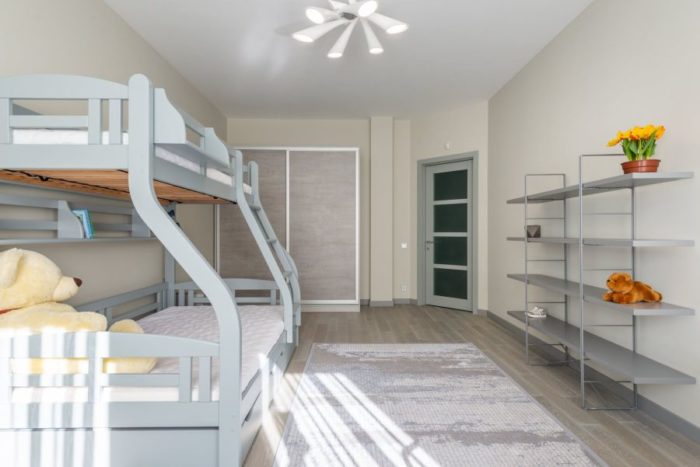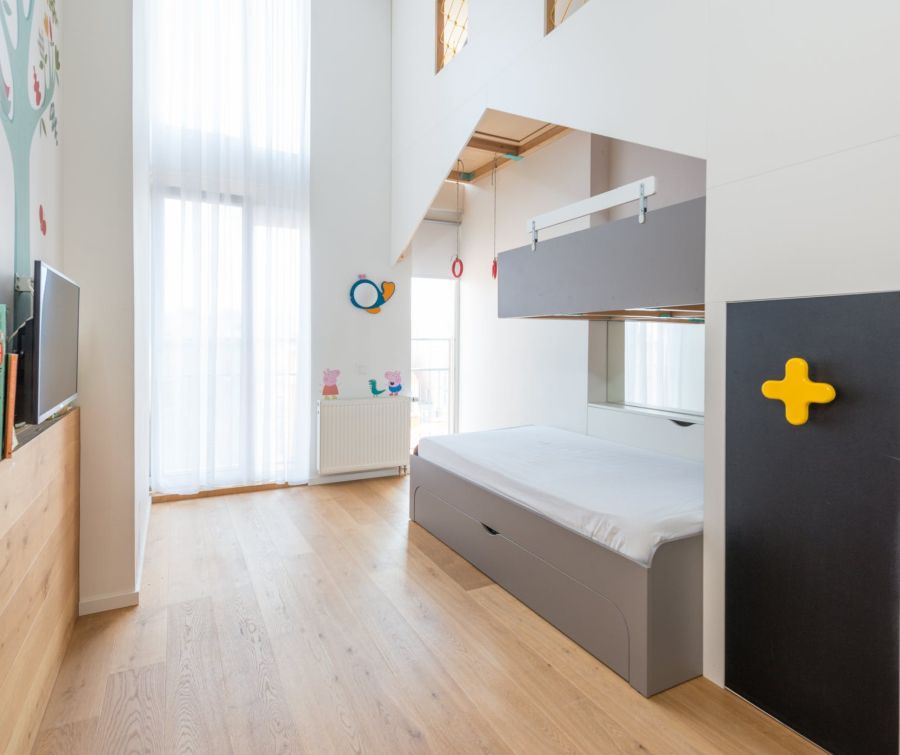Determining the right bunk bed for your room takes some research and effort. In this article, we will discuss bunk bed dimensions to make the determination process easier for you.
We know that bunk beds aren’t the first thing that comes to most people’s minds when they think about a comfortable bed since they regard them as small-sized beds for children. That is a myth!
Buying a bunk bed is a good choice if your room isn’t big enough to fit a regular-sized bed.
Types Of Bunk Bed
Before we jump on to bunk bed dimensions, let’s look at the different types of bunk beds. Here are a few of them.
1. The Standard Bunk Bed
A standard bunk bed usually has two twin size or XL twin size beds, and one of them is stacked on the top of the other. This bunk bed has a uniform look because both of its beds are of equal sizes.
You can find such bunk beds in college dorms, and they are ideal if you share your room with another person.
2. Triple Bunk Bed
A triple bunk bed is used at places where there is a lack of space. All three beds of triple bunk beds are of equal sizes, and most of the time, all these three beds are either twin-sized or XL twin-sized.
3. L-Shaped Bunk Bed
L-shaped bunk beds are visually appealing and can make even the smallest rooms look aesthetic. An L-shaped bunk bed either has a full queen-size or king-size bottom bed or two full-size or XL twin-size top beds.
An L-shaped bunk bed may have room for desks and cupboards.
4. Loft Bunk Bed
Loft bunk beds are similar to L-shaped bunk beds, but the difference is that loft beds are smaller than L-shaped bunk beds. Also, a loft bunk bed can only accommodate one person, as it has one full-size or XL twin bed.
The good thing is that loft bunk beds typically have bigger cupboards.
5. Combination Bunk Beds
Combination bunk beds are popular among parents who share their rooms with their children. By combination bunk beds, we mean bunk beds that have large bottom beds and a small upper bed.
Examples of combination bunk beds include twin over full bunk beds and twin over king bunk beds.
Bunk Bed Dimensions – Sizing And Types
Here are all the bunk bed dimensions. However, we must mention that these are rough estimations, since additional features may alter the size. It is never a bad idea to contact customer service representatives to get the exact dimensions.
1. Twin Size Bunk Beds
Twin bunk beds are nearly 75 inches long and 39 inches wide. These bunk beds are typically 60-65 inches tall. The dimensions of the mattress of a twin-size bed are 80×42 inches, making it an excellent choice for children and tweens.
Although adults can use it too, they will feel uncomfortable sleeping on such a small bed. So, we’ll recommend them to go for a full size or XL twin size bunk bed instead.
2. Full-Size Bunk Beds
The dimensions of a full-size bunk bed are 82×61 inches. These bunk beds are 65 inches tall, and their mattresses are 75 inches long and 54 inches wide.
Full-size bunk beds are equally perfect for both children and adults.
3. Queen Size Bunk Beds
Queen size bunk beds are one of the best options for two individuals who want more space or for two couples who don’t mind being cramped up.
A queen size bunk bed measures 83 inches in length and 63 inches in width. It is nearly 65 inches above the ground.
4. King Size Bunk Beds
Although king-size bunk beds are uncommon, you can still find them at furniture shops. The dimensions of a king-size bed are 77×88 inches. Usually, king-size bunk beds are 52 inches tall.
The recommended dimensions for a king-size mattress are 77×88 inches.
5. Full-Size Bed With Twin Bunk
The combination of a full-size bed with a twin bunk is popular among families whose children share rooms. Typically, the elder kid gets the full bottom bed, whereas the younger child gets the upper twin bunk.
The dimensions of this combination bunk bed are 69×79 inches.
How Tall Are Bunk Beds?

The tallness of a bunk bed depends on its type. Most of the bunk beds are 50-70 inches tall, but a triple bunk bed measures 77 inches in height.
Ideal Distance Between The Ceiling And Top Of A Bunk Bed
Most people don’t even consider the distance between their ceiling and the top of the bunk bed they are willing to buy. It can turn out to be a disaster, as bunk beds that are near the ceiling will cause discomfort.
Therefore, there must be a gap of at least 33 inches or 83 centimeters between your ceiling and the top of your bunk bed.
A Few More Things To Consider Before Buying A Bunk Bed
There are a few things that one must know before selecting a bunk bed for their room, and we are explaining some of them below.
1. The Size Of Your Room
The first thing that you should measure before buying a bunk bed is the size of your room.
If the size of your room is less than 10×10 feet, you should consider getting a twin or XL twin bunk bed. However, you can buy a full-size or queen-size bunk bed if your room measures more than 10×10 feet.
2. The Number Of People You Want To Accommodate On The Bunk Bed
The next thing that you should consider before buying a bunk bed is the number of people you want to accommodate on the bunk bed.
If you want a bunk bed for two people, a standard twin bunk bed will do. Consider a twin over full or queen size bunk bed if you want to accommodate more than two people.
3. The Height Of Your Ceiling
As we have mentioned earlier, the height of your ceiling plays a major role when it comes to buying bunk beds, especially if you are claustrophobic.
That’s why bunk beds are not a suitable option for rooms with a low ceiling.
4. Functionality
There are various types of bunk beds, and some of them have desks and cupboards to help you save some space. However, this multipurposeness comes with a costly price tag.
A Few Tips And Tricks That You Should Know About Bunk Beds
Here are a few tips and tricks that you must know before buying a bunk bed.
1. The Height Of Your Mattress
Make sure that the mattress that you are planning on buying for your bunk bed is short. It is because most bunk beds don’t have high railings to support tall mattresses.
2. Buying A Mattress Support
It is essential to buy mattress support for at least the top bed of your bunk bed, as it is beneficial for the comfort of the person sleeping on the bottom bed.
Mattresses can make squeaky noises when placed without mattress supports. Those noises are annoying for everyone, but more so for the person at the lower bunk.
Use bunkie boards or plywoods instead of box springs, as box springs will increase the height of your bunk bed.
3. Taking Safety Measures
Most people are concerned about accidentally falling from bunk beds, and their concern is understandable.
You can take safety measures to make your bunk bed fall-proof. Some of them include adding extra slats and installing additional guard rails.
4. Assemble It Properly
Although it is highly unlikely, bunk beds can collapse if you don’t assemble them properly. So, you should follow every step of the instruction to ensure that your bunk bed is sturdy.
In fact, we will recommend you ask a professional to assemble your bunk bed.
What Is A Shorty Bunk Bed?
Shorty bunk beds is another term for referring to children’s bunk beds. A shorty bunk bed is approximately 36 inches wide and 75 inches long. Also, it is almost 10 inches shorter than most bunk beds for adults.
What Are The Bunk Bed Dimensions Of A Camper?
Usually, campers have built-in bunk beds, and the dimensions of bunk beds in most campers and motorhomes are 38 inches wide and 75 inches long. However, the ideal size of a bunk bed is different for every camper.
Finalizing Your Bunk Bed Purchase
It is a good idea to visit your nearest furniture shop and buy a bunk bed from there, but you can also buy bunk beds online. However, make sure to read the size chart properly. Never ignore bunk bed dimensions – focus not just on bed dimensions, but also the height between bunks and the total height.

